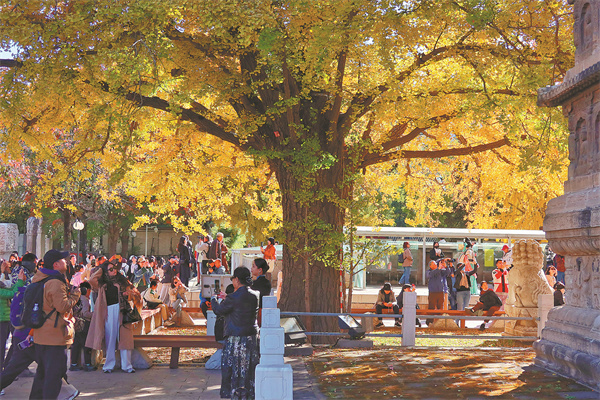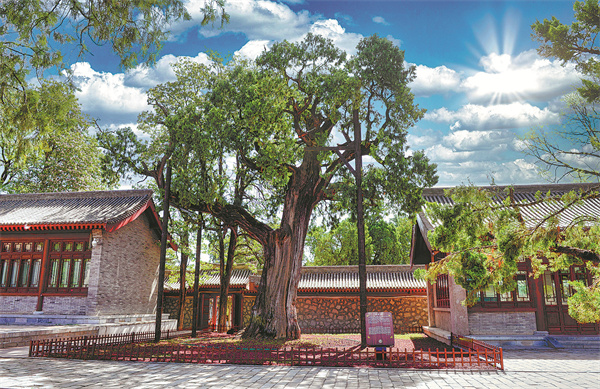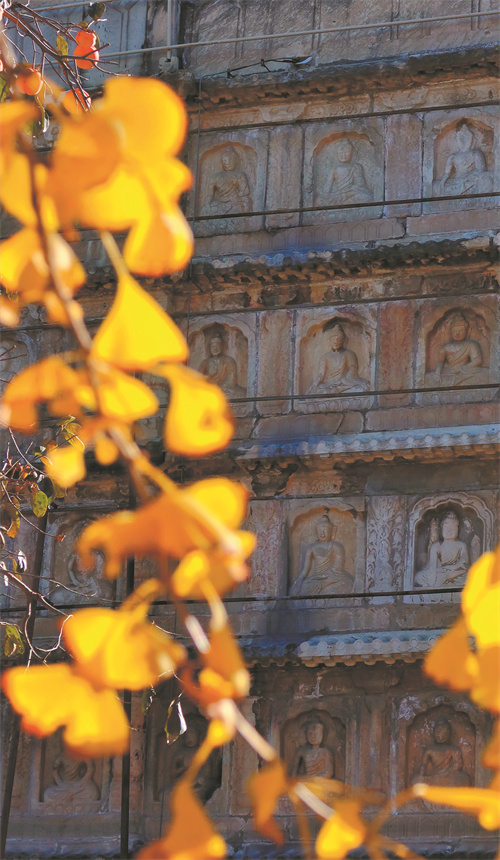
At the Beijing Stone Carving Art Museum, formerly a temple, two ginkgo trees, each with a diameter exceeding 2 meters, stand like sentinels in front of a pagoda. These ginkgos, each more than 600 years old, guard the ancient structure with timeless grace.
Since autumn, the site has been a magnet for visitors, with thousands arriving daily to capture photos and admire the golden tree leaves. On weekends, the number of visitors can soar to over 3,000.
Wu Di, who works in the museum's cultural relics management department, has been caring for the trees for six years. Each week, he conducts a special "check-up" on the ginkgos, taking photos of them from over a dozen angles to update their digital records. This meticulous monitoring helps track the trees' health, enabling Wu to promptly consult arborists for additional care and treatment.
The museum regularly invites professionals with expertise in the maintenance of ancient trees to carry out routine pruning of the ginkgos. The process requires great caution, as aside from removing dead branches, there is generally no artificial interference or arbitrary trimming involved, Wu explains.
"Our museum houses more than 2,600 artifacts, including steles, epitaphs, stone sculptures and stone carvings, but only these two ancient ginkgos are truly living relics," Wu says.
Upon entering the museum, visitors are immediately greeted by the sight of the majestic Vajra Throne Pagoda. From a distance, the pagoda appears to rest atop a tall base, with five smaller towers constructed on it. This structure, completed in 1473, blends traditional Chinese and Indian architectural styles. Flanking the pagoda are the two ginkgo trees, standing like steadfast guardians, sworn to protect the pagoda.
Wu's primary responsibility is the preservation of ancient towers, stone carvings and other cultural relics. Due to the harmonious natural landscape created by the ginkgos and the pagoda, the museum has allocated funds in recent years for the trees' protection. A donation plaque with a QR code is on one of the trees, allowing visitors to contribute to its preservation.
In September, the National Cultural Heritage Administration, the National Forestry and Grassland Administration and the Ministry of Housing and Urban-Rural Development announced the first-round list of ancient and notable trees and cultural relic sites for collaborative protection. Among the 28 sites selected were the ginkgo trees at the Beijing Stone Carving Art Museum.

The list is a result of a nationwide campaign to preserve ancient and notable trees, designating such trees for better preservation efforts. Ancient trees are classified as those over 100 years old, while notable trees hold historical, cultural, or ecological significance. The ancient trees included on the list are all over 500 years old.
The integration of cultural relic protection with the preservation of ancient trees within a systematic framework stands out as a key highlight of this list, according to Zhang Zhixiang, a professor at Beijing Forestry University, as reported by the Beijing News in October. He emphasizes that ancient and notable trees are regarded as "living cultural relics". He says the exploration of the "dual protection" model for cultural and ecological heritage has, to some extent, strengthened public awareness of the protection of ancient trees.
ALSO READ: Taishan's ancient trees remain firmly rooted
According to the list, the ancient and notable trees selected are highly compatible with the types of cultural relics they are paired with, forming a distinct feature of matching the characteristics of the tree species with the functions of the relics. Examples include ginkgos paired with historic pagodas, cypresses with imperial tombs, and groups of trees growing at large cultural heritage sites.
At the Jinci Temple in Taiyuan, Shanxi province — a royal ancestral temple dating to the Jin Dynasty (265-420) — a nearly 3,000-year-old cypress tree lies gracefully before a majestic hall, resembling a crouching dragon. The cypress is also listed on the collaborative protection list.
Guo Baoping, director of the Jinci Temple Museum where the temple is located, says that to ensure the scientific and effective protection of ancient trees, extensive research and advanced technologies have been applied. Measures include establishing health archives for each tree and developing patented technology to address issues such as soil compaction and water imbalance. These measures have expanded the space for potential root growth by up to 40 percent.
Additionally, the museum has collaborated with a local agricultural university to set up dedicated laboratories for joint research efforts.

The core of future protection lies in treating the cypress as an irreplaceable piece of cultural and natural heritage, says Guo. "Through a collaborative model of State leadership, technological support, systematic management and public participation, the tree will better serve as a living narrative of Chinese civilization."
The temple, cemetery and family mansion of Confucius, the great Chinese philosopher and educator from the 6th to 5th centuries BC, form a large complex of monuments located in Qufu, Shandong province. This complex also houses thousands of ancient trees. It is included in the list due to its cluster of 310 ancient trees, each over 500 years old.
Confucius and Confucian culture have long admired the spirit of pine and cypress trees, associating the cypress with noble character and high moral values. For over 2,000 years, Qufu, the hometown of Confucius, has continued the tradition of planting the species.
"In Qufu, there are more than 10,000 trees that are over 100 years old. The locals have always demonstrated a strong awareness of tree protection," says Cao Shenglei from the Qufu Ancient and Notable Trees Protection Center.
ALSO READ: Ancient trees treasured in Chongqing
In the Temple of Confucius, legend has it that Confucius personally planted a cypress tree. The tree, considered a symbol of Confucian values, has endured cycles of death and revival over millennia; each time the tree has died, local people have planted a new cypress in the same place. The tree today is the fifth-generation successor of the original.
For two millennia, celebrated poets and emperors have composed verses in praise of the tree, while master painters have captured its form through their art. The tree is accompanied by more than a dozen inscribed steles, including calligraphy dedicated by Emperor Kangxi and Emperor Qianlong from the Qing Dynasty (1644-1911).

"The cypress tree has a well-documented lineage with extensive historical records. It is a witness to history, a reflection of Qufu's culture, and a true living cultural relic," Cao says.
In his view, the release of the list not only emphasizes regular maintenance but also calls for deeper exploration and interpretation of the cultural value behind the trees. This has been the focus of the Qufu Ancient and Notable Trees Protection Center in recent years.
Founded in 2021, the center has conducted detailed surveys and routine maintenance of ancient trees while actively engaging in public education. By leveraging the cultural significance of the trees, they have promoted Confucian values and developed a variety of cultural and creative products.
Cao notes that recent national policies and regulations have provided new avenues for securing funds for ancient tree protection, offering clear legal grounds for such applications.
In March, China implemented its first national-level regulations dedicated to the protection of ancient and notable trees. These regulations established a legal framework for resource surveys, conservation and cultural preservation, while also imposing penalties for any damage to these natural treasures — effectively addressing gaps in previous legal measures.
Zhang Liming, director of the ecological protection and restoration department of the National Forestry and Grassland Administration, says the regulations align with China's broader goals of building an "ecological civilization" and preserving cultural identity.
Zhu Xingxin and Zhao Ruixue contributed to this story.


